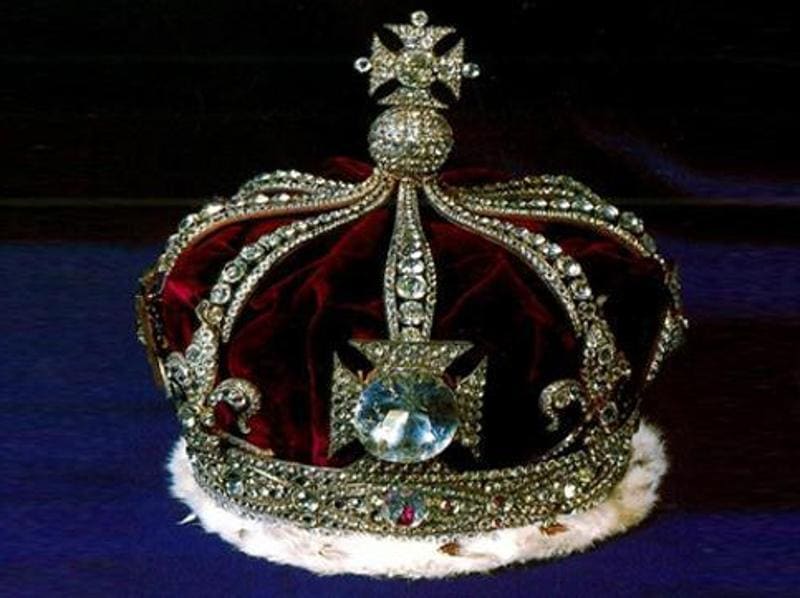 |
| Image Source: Hindustan Times |
Kohinoor diamond is one of the largest cut diamonds in the world, weighing 105.6 carats (21.12 g). It is part of the British Crown Jewels.
History of Kohinoor diamond
Origin
The diamond may have been mined from
Kollur Mine, a series of 4-meter (13 ft) deep gravel-clay pits on the south
bank of the Krishna River in the Golconda (present-day Andhra Pradesh), India.
It is impossible to know exactly when or where it was found, and many
unverifiable theories exist as to its original owner.
Early history
Babur, the Turco-Mongol founder of the
Mughal Empire wrote about a “famous” diamond that weighed just over 187 old
carats – approximately the size of the 186-carat Koh-i-Noor. Some historians
think Babur’s diamond is the earliest reliable reference to the Koh-i-Noor.
According to his diary, it was acquired by Alauddin Khalji, the second ruler of
the Khalji dynasty of the Delhi Sultanate, when he invaded the kingdoms of
southern India at the beginning of the 14th century and was probably
in the possession of the Kakatiya dynasty. It later passed to succeeding
dynasties of the Sultanate, and Babur received the diamond in 1526 as a tribute
for his conquest of Delhi and Agra at the Battle of Panipat.
Shah Jahan, the fifth Mughal emperor, had
the stone placed into his ornate Peacock Throne. In 1658, his son and
successor, Aurangzeb, confined the ailing emperor to Agra Fort. While in the
possession of Aurangzeb, it was allegedly cut by Hortense Borgia, a Venetian
lapidary, reducing the weight of the large stone to 186 carats.
Following the 1739 invasion of Delhi by
Nadir Shah, the Afsharid Shah of Persia, the treasury of the Mughal Empire was
looted by his army in an organized and thorough acquisition of the Mughal
nobility’s wealth.
After Nadir Shah was killed and his empire
collapsed in 1747, the Koh-i-Noor fell to his grandson, who in 1751 gave it to
Ahmad Shah Durrani, founder of the Afghan Empire, in return for his support.
One of Ahmed’s descendants, Shuja Shah Durrani, wore a bracelet containing the
Koh-i-Noor on the occasion of Mountstuart Elphinstone’s visit to Peshawar in
1808.
 |
| Image Source: The Royal Watcher |
Acquisition by Queen Victoria
On 29 March 1849, following the conclusion
of the Second Anglo-Sikh War, the Kingdom of Punjab was formally annexed to
Company rule and the Last Treaty of Lahore was signed, officially ceding the
Koh-i-Noor to Queen Victoria and Maharaja’s other assets to the company.
The lead signatory of the treaty for the
eleven-year-old Maharaja Duleep Singh was his commander-in-chief Tej Singh, a loyalist of Maharaja Gulab Singh who had previously owned the Koh-i-Noor and
gained Kashmir from the Sikh empire, via treaty with Britain, following the
First Anglo-Sikh War.
Crown Jewel
After Queen Victoria’s death, the Koh-i-Noor was set in the Crown of Queen Alexandra, the wife of Edward VII, which was used to crown her at their coronation in 1902. The diamond was transferred to Queen Mary’s Crown in 1911, and finally to The Queen Mother’s Crown in 1937. When The Queen Mother died in 2002, the crown was placed on top of her coffin for the lying-in-state and funeral.
All these crowns are on display in the
Jewel House at the Tower of London with crystal replicas of the diamond set in
the older crowns. The original bracelet given to Queen Victoria can also be
seen there. A glass model of the Koh-i-Noor shows visitors how it looked when
it was brought to the United Kingdom. Replicas of the diamond in this and its
re-cut forms can also be seen in the ‘Vault’ exhibit at the Natural History
Museum in London.
During the Second World War, the Crown Jewels were moved from their home at the Tower of London to Windsor Castle.[62] In 1990, The Sunday Telegraph, citing a biography of the French army general, Jean de Lattre de Tassigny, by his widow, Simonne, reported that George VI hid the Koh-i-Noor at the bottom of a pond or lake near Windsor Castle, about 32 km (20 miles) outside London, where it remained until after the war.
The only people who knew of the hiding place were the king and his librarian, Sir Owen Morshead, who revealed the secret to the general and his wife on their visit to England in 1949.
Written By - Violet Priscilla S
Edited By - Anamika Malik










1 Comments
Great enjoyed while reading 👍
ReplyDelete